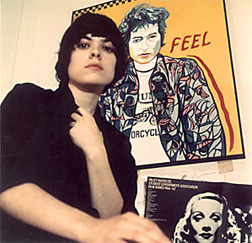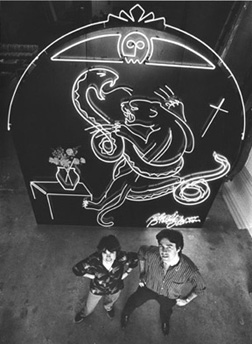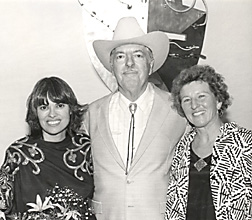


In
1976, Peter Goulds selected Lakich's work for the inaugural exhibition of
his new L.A. Louver Gallery in Venice, California. In 1978, she was invited
by Galerie au Fond de la Cour (now Galerie Gabrielle Maubrie) to come to Paris
and create ten neon sculptures using French materials and French craftsmen
to fabricate them. Because neon had been developed in Paris in 1910, Lakich
thought France would have even more supplies than were available in the U.S.
To her shock, there were only eight colors of neon tubing available, and they
were all pastel. "Having never had a pastel thought in my life,"
she says, "I was devastated. After about three weeks of near catatonic
stupor, I set about to rework all of my patterns into pastels." Her exhibition
was a resounding success. The French, at first skeptical, said her work was
"comme Matisse, comme Leger."
By the late 1970s, Lakich was painfully aware that
neon was dying, and that it had been dying as a medium since the late 1950s.
It was becoming increasingly difficult to get the beautiful colored glass
and other materials. As neon fabrication was being discontinued, the result
of the rise of plastic and cheap fluorescent lighting, neon tube benders were
also disappearing. Concerned about the future of neon, Lakich felt that the
only thing that would turn around the decline of neon would be to establish
a museum dedicated to the exhibition of what she considered America's greatest
art form. "Neon is associated with the highest aspirations and fantasies
of the American dream, as well as the lowest manifestation of commercialism
and banality. There is no other art form that is as symbolic of the American
spirit." In 1981, she and Richard Jenkins co- founded the Museum
of Neon Art (MONA) in her 5,000 sq.ft studio in downtown Los Angeles.
Lakich's retrospective exhibition at the Museum of
Neon Art in 1985 was accompanied by her self-published award-winning book
Neon Lovers Glow in the Dark. The show was seen by Mr. Akira Okada, a
Japanese entrepreneur, who fell in love with Lakich's work, and arranged for
her 60-piece exhibition to inaugurate the new Touko Museum of Contemporary
Art in Tokyo. The show received major sponsorship from Japan's C. Itoh corporation,
the world's largest trading company. Lakich's book was expanded, translated
into Japanese, and served as the catalog for the exhibition. The Museum purchased
eight works for their collection totaling $100,000. The exhibition subsequently
traveled to five U.S. cities between 1989 and 1991.
In 1989, Lakich received public
commissions for Unity Savings Bank in Brentwood, The Washington Building in
downtown Los Angeles, the Columbia Square Building in San Diego and California
Plaza in downtown Los Angeles. The
75-ft. long L.A.
Angel, for California Plaza, was completed
in 1992t.
"Mourning Becomes Electric," (1992)
Lakich's second solo exhibition at the Museum of Neon Art, chronicled a persistent
theme in her work—the transformative power of memorial expressed through
the transcendent medium of light. While still working in metal sculpture with
neon, the artist's interest had shifted from drawing with luminous tubing
to painting with colored light. Featured were her AIDS series, the Icons and
her newest portraits, including The Ghost of Rock 'n' Roll and
Requiem, a tribute to her longtime companion Mary Carter.
In 2001, Lakich's solo exhibition, "Sirens and Other Neon Seductions" inaugurated the new galleries at CSUN (California State University at Northridge). The university's galleries had been destroyed in the 1994 earthquake. The exhibition featured much of Lakich's personal work along with a site-specific installation that she created especially for the exhibition. For "Sirens," a desert gay bar, Lakich created interactive works of abstract figures interspersed with commercial neon beer signs, bar stools and a pool table. Visitors loved interacting with the life-size bar denizens; they found Sticks and Stones particularly moving.
Guardian, which had been commissioned in 1997 by Long Beach Memorial Medical Center but was interrupted for a myriad of reasons, was re--commissioned in 2004 for Miller Children's Hospital at Long Beach Memorial. Lakich completed the ethereal work in October, 2004.
The studio/gallery regularly displays more than 65 of Lakich's neon sculptures, many of them large-scale.
Lakich continues to create personal work like her recent Self-Serv and Self-Portrait with Blonde Bombshell, as well as commissions for public and private spaces and the neon signage that sparked her love for the medium.
In 2007, she published a new 160-page hardcover book LAKICH: For Light. For Love. For Life. which contains over 250 photos of her neon sculptures, 230 in full color.
In 2009, Lakich completed her largest public art sculpture to date—-the 114-ft. long Flyaway for the Van Nuys FlyAway bus terminal in Van Nuys, California. Constructed of honeycomb aluminum with painted copper and brass laminates and found objects, the sculpture features 700 feet of neon tubing powered by 200,000 volts of electricity.
In 2011, she was invited to be one of the "Downtown Legends," a show of five artists curated by Dale Youngman for Art Share in Los Angeles. Lakich curated a new work for the exhibition--American Idol.
Walt Whitman wrote: "I sing the body electric." Lili Lakich continues that song in a new medium.

